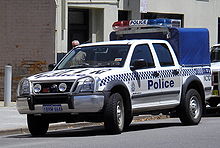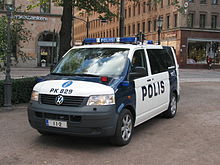- Police van
-
A police van (also known as a paddywagon, Black Maria or police carrier) is a type of vehicle operated by police forces. Police vans are usually employed for the transportation of prisoners inside a specially adapted cell in the vehicle, or for the rapid transportation of a number of officers to an incident.Contents
History
Early police vans were in the form of horse-drawn carriages, with the carriage being in the form of a secure prison cell. In the modern age, motorised police vans replaced the older Black Maria and Paddywagon types as they were usually crudely adapted for accommodation of prisoners.
The need for a secure police van was realised when prisoners who were resisting arrest needed to be transported. The concern, was that if transported in a conventional patrol car, the prisoner may attack the officers during the journey.
To combat this, police vans were designed with a fixed steel cage in the rear of the vehicle effectively separating the prisoner from the officers.
Etymology
Paddywagon
Modern Police Van, Lewiston, Maine.
 Modern Western Australian Police Force Police Van
Modern Western Australian Police Force Police Van
The word paddywagon is of American origin. The precise origin of the term is uncertain and disputed, though its use dates back to at least the beginning of the 1900s.[1] There are at least two theories as how the phrase originated.[2]
- The most prevalent theory is based on the term "Paddy" (a common Irish shortening of Patrick), which was used (sometimes as derogatory slang) to refer to Irish people.[3] Irishmen made up a large percentage of the officers of early police forces in many American cities. Thus, this theory suggests that the concentration of Irish in the police forces led to the term "paddywagon" being used to describe the vehicles driven by police.
- An alternative theory is similarly based on the term "Paddy" but states that the term arose due to the high crime level among Irish immigrants.[4]
Black Maria
These vehicles were usually painted black or a very dark blue. In the United Kingdom, Ireland, Australia, New Zealand and the United States, a police wagon was also sometimes called a Black Maria (pronounced like Mariah /məˈraɪ.ə/). The origin of this term is equally uncertain. The OED lists the first usage as the Boston Evening Traveller from 1847 which mentions them as a new type of wagon. Brewer's Dictionary of Phrase and Fable suggests the name came from Maria Lee, a large and fearsome black keeper of a sailors' boarding house who the police would call on for help with difficult prisoners. The term is still used today in parts of Britain for the vehicle that transports prisoners from jail to court, appearing in the songs "Guns of Brixton" by The Clash and "Adios Hermanos" by Paul Simon. Frequently, blackened-windowed buses are also used for the same purpose.[5]
The term also exists in Norwegian, where the same vehicle is called "maja" or "svartemaja" (alt. "-marje", "-marja"), originating from "Black Maria", and in Finnish as "mustamaija". In Serbian, it is "marica" (with a small "m"), while "Marica" with a capital "M" is a diminutive of several female names. The term 'Schwarze Maria' is also common in Germany.
The Black Maria is also called 'Mothers Heart' as it is said that there is always room for one more.
The term is often used in some areas of Australia, specifically New South Wales[6] and Queensland[7] to refer to a general duties vehicle with a prisoner cage on the back. Australian police vans are typically based on small utility vehicles such as the Holden Rodeo, Holden Crewman, or Toyota Hilux. In Victoria, Australia the term Divisional Van (or Divvy Van for short) is used. In Western Australia, paddywagon is common amongst the general population but divvy van appears to be favoured by the police themselves.[citation needed]
Use of vans
Individual police stations may have a van for the accommodation of prisoners and transportation of officers.[8] The Metropolitan Police Service, England makes extensive use of these, particularly among the Territorial Support Group, which carries out public order duties and adapts the vans to carry riot protection equipment.
Police vans may have a flip down wire shield across the windscreen,[8] which helps prevent projectiles from damaging the vehicle.
Many forces now differentiate between a "Carrier" - a vehicle used for Public Order situations and therefore equipped with shields etc and what is commonly known as a "Cub Van" - a small van with a cage in the back.
See also
References
- ^ Oxford English Dictionary (2002); ISBN 978-0195219425
- ^ Partridge's Concise Dictionary of Slang and Unconventional English (1989); ISBN 0-02-605350-0
- ^ Webster's Third New International Dictionary (1993); ISBN 0-87779-201-1 , and The Cassell Dictionary of Slang (1998) ISBN 0-304-34435-4
- ^ Sowell, Thomas. The Economics And Politics of Race, p. 69
- ^ Quinion, Michael. Black Maria, World Wide Words
- ^ "NSW Police Vehicles". Inthejob.com. http://www.inthejob.com/nsw.html. Retrieved 2009-06-09.
- ^ [1][dead link]
- ^ a b [2][dead link]
External links
Categories:- Police vehicles
- Irish American history
Wikimedia Foundation. 2010.





